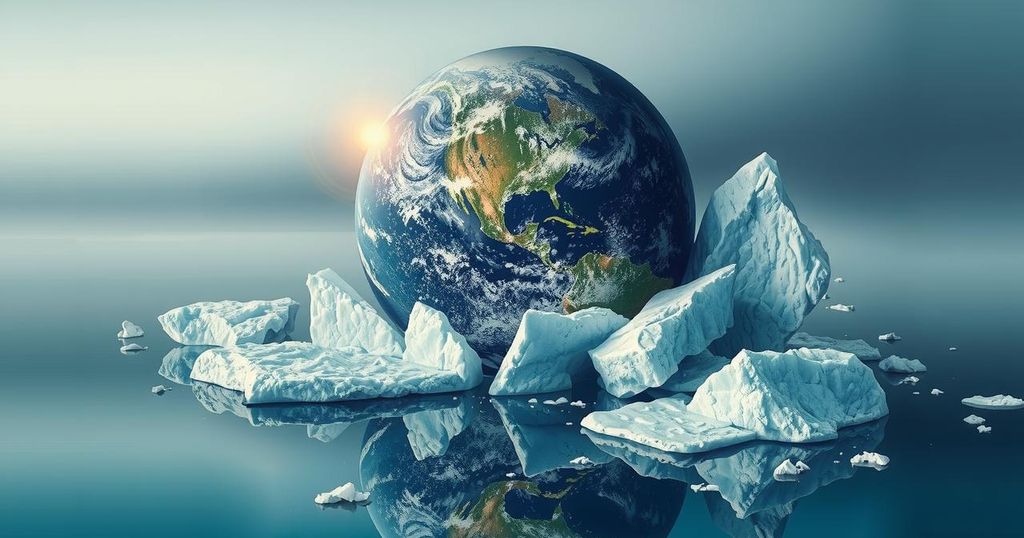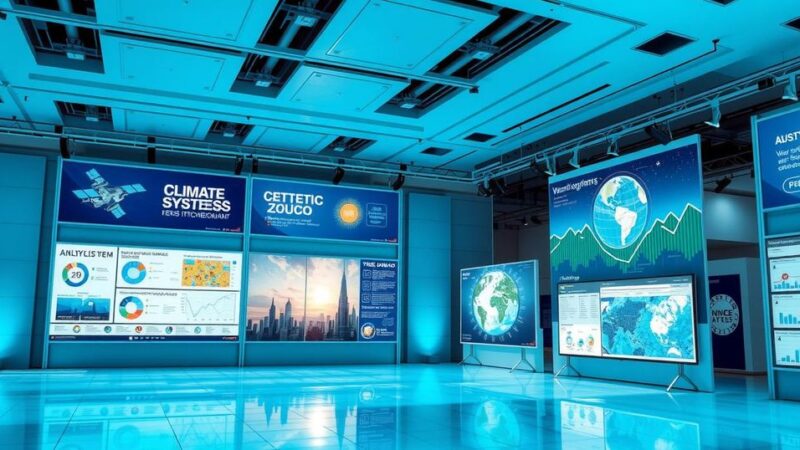New satellite data shows polar sea ice reached a record low of 6.08 million square miles on February 13, 2025, sparking concerns about significant climate shifts. The melting ice threatens global temperatures, wildlife habitats, and sea levels. Experts indicate that urgent action to reduce carbon emissions is necessary to mitigate further losses and stabilize climates.
Recent satellite observations indicate an alarming decrease in sea ice in both the Arctic and Antarctic regions, with coverage plummeting to an unprecedented 6.08 million square miles (15.76 million square kilometers) on February 13, 2025. Such rapid ice melting suggests a perilous shift in Earth’s climate dynamics, with repercussions extending well beyond polar regions.
The significance of polar ice cannot be overstated; it serves as Earth’s natural thermostat by reflecting sunlight, which helps maintain global temperature equilibrium. The loss of sea ice exposes darker ocean water that absorbs more heat, a process known as the albedo effect, thereby intensifying global warming. According to Walter Meier of the U.S. National Snow and Ice Data Center, Antarctica’s ice has entered “a new regime of lower ice extents,” marking a significant deviation from established historical trends.
A study conducted in 2024 by scientists at the Laboratoire d’Études en Géophysique et Océanographie Spatiales corroborated the substantial losses of Arctic and Antarctic ice due to climate change, attributing this phenomenon to ascending ocean temperatures.
As polar ice continues to deteriorate, rising sea levels pose an increasing threat to coastal urban centers such as New York, Miami, and Jakarta, raising the risks of flooding and severe storms. Diminished ice sheets in Greenland and Antarctica heighten the vulnerability of millions living in low-lying regions. Furthermore, the depletion of ice is disrupting critical ocean currents, notably the thermohaline circulation, which plays a vital role in regulating global weather patterns. This disruption could lead to intensified hurricanes, extended droughts, and erratic monsoons.
Wildlife is concurrently facing dire challenges due to this ecological upheaval. Species such as polar bears, seals, and walruses are losing essential hunting and breeding grounds, while penguin populations in Antarctica confront diminishing habitats. The absence of stable ice threatens numerous species with decline or extinction, destabilizing already fragile ecosystems.
Satellite technology has confirmed this alarming trend, with ice coverage rebounding slightly to 6.11 million square miles (15.84 million square kilometers) on February 15, 2025. However, this figure remains significantly lower than average levels observed in previous years. Analysts have noted a drastic change since 2016, when Antarctic sea ice experienced sudden declines that have not since recovered, indicating a potential permanent shift in climate conditions.
Looking ahead, the upcoming months will be crucial in determining the potential for ice recovery or whether this unprecedented decline marks a new normal. Scientists are thoroughly investigating how rising ocean temperatures and evolving weather patterns may influence refreezing trends. Experts unanimously agree that reducing global carbon emissions is essential in slowing this alarming trend. The ultimate fate of Earth’s polar ice hinges on the urgency with which nations undertake measures to mitigate greenhouse gas emissions and transition towards clean energy solutions.
In summary, the dramatically declining polar ice levels reveal a significant and troubling shift in the Earth’s climate system, with severe implications for global weather patterns, sea levels, and wildlife. The urgency to address rising carbon emissions has never been greater, as the fate of polar ice—and by extension, the planet—depends on the immediate actions taken by nations worldwide. Without swift and effective measures, the consequences of these changes could prove catastrophic for future generations.
Original Source: dailygalaxy.com






